On Wednesday, a grand jury declined to indict New York City Police Officer Daniel Pantaleo for Eric Garner's death, which a medical examiner had ruled a homicide by "compression of the neck." Like Michael Brown's death in Ferguson, Missouri, the tragedy received national attention for involving an unarmed black man and a white police officer. Unlike Brown's death, however, Garner's killing was also filmed by an onlooker, and the video clearly showed Garner in a chokehold and insisting he couldn't breathe. The New York Police Department is now implementing a pilot program that puts cameras on officers and President Barack Obama recently asked Congress for $75 million in funding for 50,000 body cameras. But clearly video evidence is not enough alone to hold police accountable for using deadly force against unarmed citizens.
Studies do show that cameras can make a real difference in police behavior and reduce complaints. One department in Rialto, California, saw that "citizen complaints against officers fell 88 percent in the first year, and use of force by officers declined 60 percent. That’s an indication that cameras not only create video evidence of events, but also actually change the way everyone involved behaves. Videos can also provoke public outrage, pressuring departments to reform.
However, cameras aren't a cure-all for police accountability for deadly force and racial bias. Police still have wide leeway for using deadly force. Juries remain deferential to officers' judgements of when to incapcitate a person or fire their weapons. As Amanda Taub has explained at Vox, "That means that to press criminal charges in a police shooting, the prosecutor has a heavy burden to overcome. The officer is likely to claim that he believed the suspect was a threat and made a split-second decision to use force. The jury is likely to believe him, even if his decision was a bad one." At The Nation, Chase Madar pointed to the case of Kajieme Powell, John Crawford III, and Milton Hall, all of whom were shot by police and all of whose deaths were filmed on camera. None resulted in charges.
In other words, body cams can help—but they still don't entirely fix police abuse. Juries still show officers extreme deference, even when police violence gets caught on tape.
